Troubleshoot Problems with Deploying Farm SolutionsTop
This topic applies to:
- WSS 3.0 and MOSS 2007
- SharePoint Foundation 2010/2013 and SharePoint Server 2010/2013/2016
Several issues and their corresponding solutions are described below. Click the link to jump to the appropriate issue.
Issue 1: Copying or Removing Assemblies
With SharePoint 2010 and 2013, we sometimes see failures when trying to copy assemblies to the Global Assembly Cache (GAC) or remove assemblies or other files from the bin or 14 or 15 hive during solution retraction and/or deployment.
Resolution:
- Restart the SharePoint 2010/2013 Administration service on all of the Web Front End servers (all servers on the farm where the Foundation Web Application service is running).
Restart the SharePoint 2010/2013/2016 Timer service as well.
 NOTE: The SharePoint Administration service carries out the actual removing and adding of files during deployment. Restarting the service works most of the time because the service should release the handle on a file. However, if the Administration service does not release the handle on the file, then deployment can fail. Restarting the timer service on SharePoint 2010/2013 will restart all SharePoint 2010/2013 timer jobs and you will need to delay installation for a while, until all of those jobs have had a chance to complete.
NOTE: The SharePoint Administration service carries out the actual removing and adding of files during deployment. Restarting the service works most of the time because the service should release the handle on a file. However, if the Administration service does not release the handle on the file, then deployment can fail. Restarting the timer service on SharePoint 2010/2013 will restart all SharePoint 2010/2013 timer jobs and you will need to delay installation for a while, until all of those jobs have had a chance to complete.
-
Remove the solution.
-
Reinstall the solution.
For more information, see:
http://msdn.microsoft.com/en-us/library/aa544500.aspx
Top
Issue 2: Deployment Fails or Times Out
Deployment fails, and the reason is not clear from the error shown in installation feedback (or just shows time out errors), or the Bamboo GUI installer appears to stop in the middle of the deployment, and eventually times out.
The Timer Job Definitions in Central Administration may show one or more persistent “one time” timer jobs listed.
Manual installations using stsadm also fails to complete the installation.
Resolution:
-
Delete the one-time timer jobs listed in the timer job definition list. Restart the SharePoint 2010/2013 Timer service on each server in the farm running the Foundation Web Application service.
Try the installation again.
-
Any solutions that show up in on the Solution Management page in Central Administration with a status of “undeployed” or “error” need to be either deployed manually in Solution Management, or removed, if you are going to run the Bamboo GUI installer. For more information, see Installation stops at the Repair Remove or Install screen
-
Run the stsadm installation using the -local rather than the -immediate parameter for stsadm -deploysolution. This will not invoke the timer service. As stated in this Technet article:
-local “Deploys the solution synchronously on the local computer only. The timer service is not used.”
For more information about which server is running the Windows SharePoint Services Web Application Service, look in Central Administration:
– on SP 2007 in Operations > Servers in Farm
– on SP 2010 in System Settings > Manage Servers in this Farm
- Clear the SharePoint Configuration cache. The Web Front End servers may be out of sync. For more information and instructions see Clear the SharePoint Configuration Cache for Timer Jobs.
If you experience issues with WSS and MOSS timer jobs failing to complete are receiving errors trying to run psconfig, clearing the configuration cache on the farm is a possible method for resolving the issue. The config cache is where we cache configuration information (stored in the config database) on each server in the farm. Caching the data on each server prevents us from having to make SQL calls to pull this information from the configuration database. Sometimes this data can become corrupted and needs to be cleared out and rebuilt. If you only see a single server having issues, only clear the config cache on that server, you do not need to clear the cache on the entire farm.
To clear the cache a single server, follow the steps below on just the problem server.
- Stop the OWSTIMER service on ALL of the MOSS servers in the farm.
-
On the Index server, navigate to:
Server 2003 location: Drive:Documents and SettingsAll UsersApplication DataMicrosoftSharePointConfigGUID and delete all the XML files from the directory.
Server 2008 location: Drive:ProgramDataMicrosoftSharePointConfigGUID and delete all the XML files from the directory.
-
Delete all the XML file in the directory.
NOTE: ONLY THE XML FILES, NOT THE .INI FILE.
- Open the cache.ini with Notepad and reset the number to 1. Save and close the file.
- Start the OWSTIMER service on the Index server and wait for XML files to begin to reappear in the directory.
- After you see XML files appearing on the Index server, repeat steps 2, 3 & 4 on each query server, waiting for XML files to appear before moving to subsequent servers.
- After all of the query servers have all been cleared and new .xml files have been generated, proceed to the WFE and Application servers in the farm, following steps 2, 3, 4 and 5 for each remaining server.
Top
Issue 3: Copying a File Failed
This is the error message that you get: “Copying of this file failed. This operation uses the SharePoint Administration service (spadmin), which could not be contacted. If the service is stopped or disabled, start it and try the operation again.”
Resolution:
For instructions and more information, see this MSDN article.
Top
Issue 4: Resources Scoped for one Web App must be deployed to more Web Apps
This is the error message that you see: “This solution contains resources scoped for a Web application and must be deployed to one or more Web applications.”
Resolution:
Usually this can be resolved by running the Bamboo GUI installer, removing the product, and then reinstalling it.
We have also found that if the solution is showing up in the Solution Management page as installed but not deployed, you can try to run a manual deployment using stsadm.
See Best Practices for Installing Bamboo Products
Also see MSDN Issues Deploying SharePoint Solution Packages
Top
Issue 5: Cannot Find a Certain File
After an apparently successful deployment, you see errors about not being able to find file(s) when attempting to view products on a page.
Resolution:
Be sure to exclude directories such as %systemroot%Program FilesCommon FilesMicrosoft SharedWeb Server Extensions from file level antivirus scanning, or you may find that files that were deployed in that directory will be removed when the antivirus scan runs.
For more information, see this TechNet article.
Top
 Upgrade the Workflow Conductor Core Component called Control Panel. Please see Upgrading your Bamboo Web Part for information about how to use the installation files to upgrade Bamboo products.
Upgrade the Workflow Conductor Core Component called Control Panel. Please see Upgrading your Bamboo Web Part for information about how to use the installation files to upgrade Bamboo products.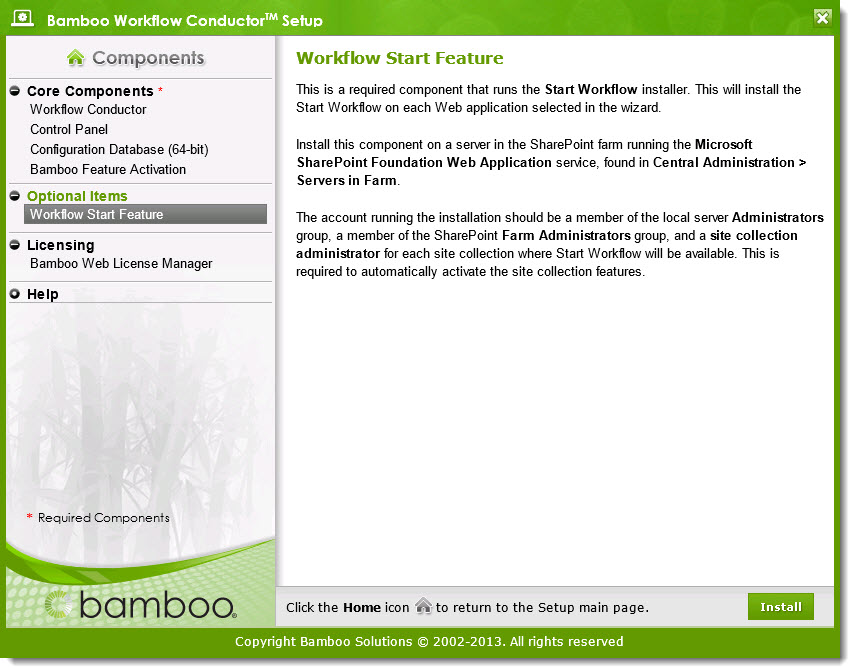 (OPTIONAL) Upgrade the Workflow Start Feature.
(OPTIONAL) Upgrade the Workflow Start Feature.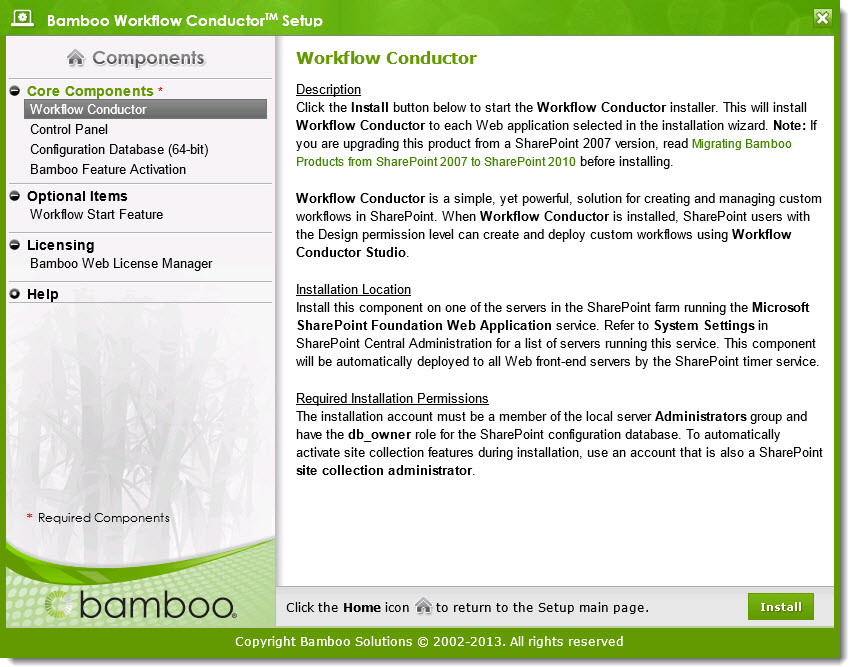 Upgrade the Workflow Conductor Core Component called Workflow Conductor. Please see
Upgrade the Workflow Conductor Core Component called Workflow Conductor. Please see 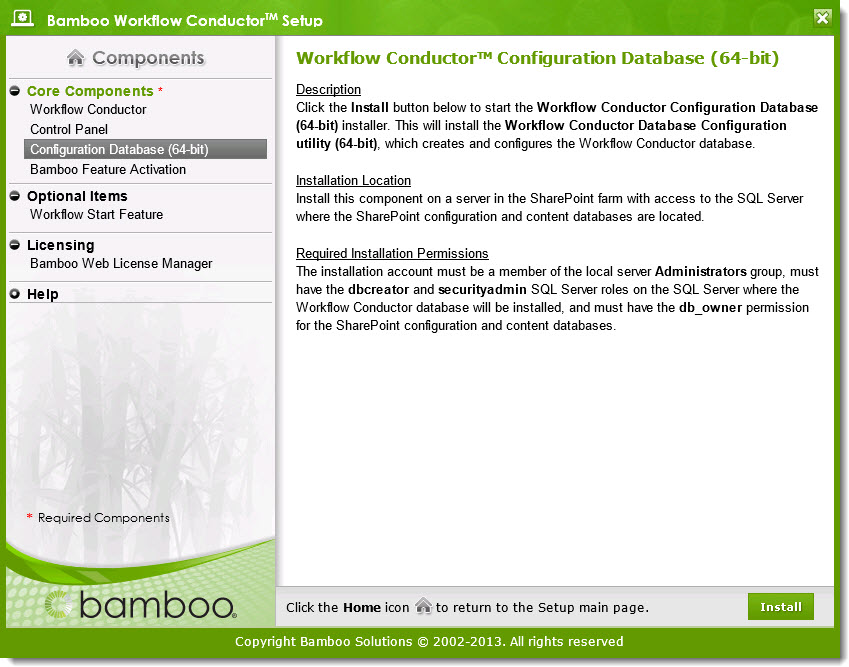 Upgrade the Workflow Conductor Core Component called Configuration Database. Please see
Upgrade the Workflow Conductor Core Component called Configuration Database. Please see 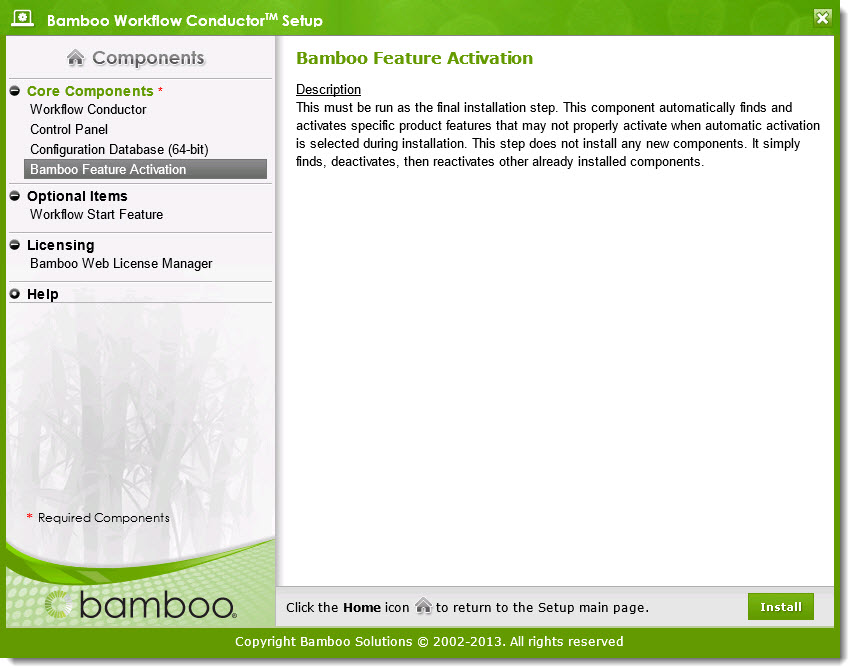 Run the Bamboo Feature Activation Component. Running this component doesn’t upgrade any software. Instead, it finds, deactivates, and then re-activates Workflow Conductor features previously installed/upgraded. See
Run the Bamboo Feature Activation Component. Running this component doesn’t upgrade any software. Instead, it finds, deactivates, and then re-activates Workflow Conductor features previously installed/upgraded. See 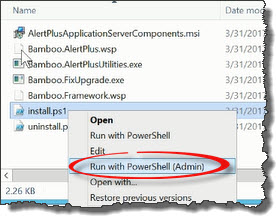 Run the Install.ps1 from a WFE server in PowerShell as an admin.
Run the Install.ps1 from a WFE server in PowerShell as an admin.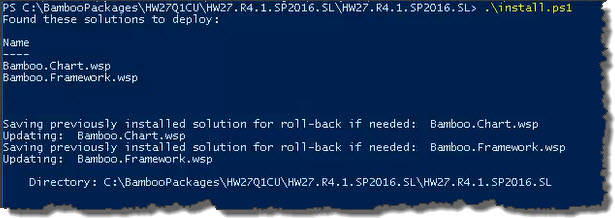 The script will look for WSPs in the install folder and list those found.
The script will look for WSPs in the install folder and list those found. When the deployment completes, deployment status information will be displayed for each solution.
When the deployment completes, deployment status information will be displayed for each solution.
 The script will look for WSPs in the install folder and list those found. It will uninstall them in alpha order.
The script will look for WSPs in the install folder and list those found. It will uninstall them in alpha order.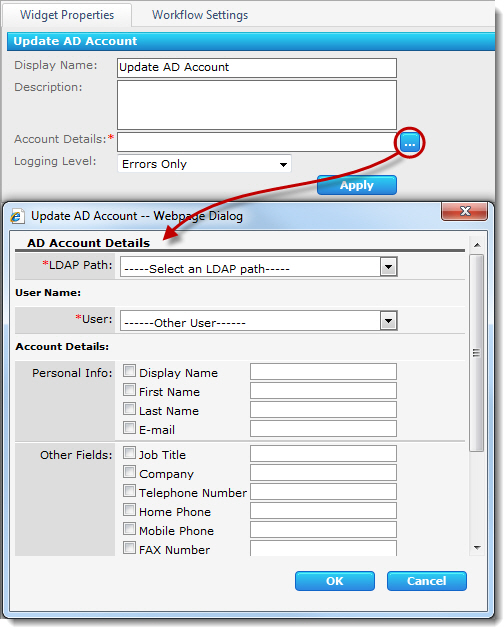
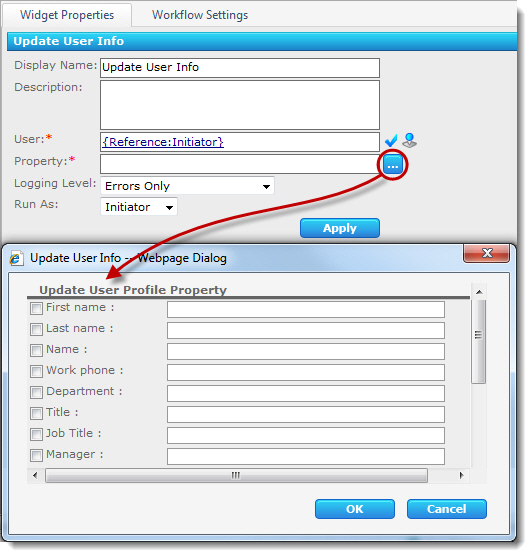 The Update User Info widget updates one or more user profile properties for a SharePoint user in the site collection. The widget has the following features and options:
The Update User Info widget updates one or more user profile properties for a SharePoint user in the site collection. The widget has the following features and options:
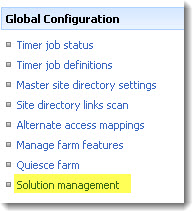
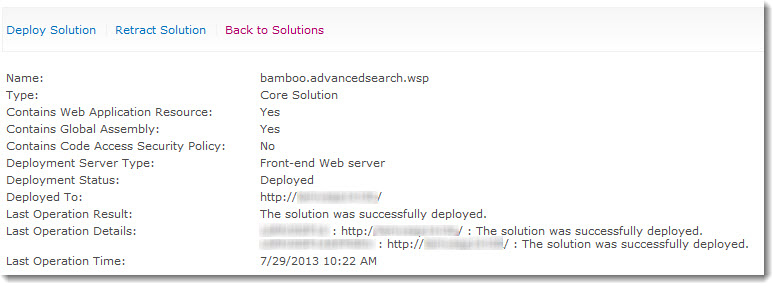
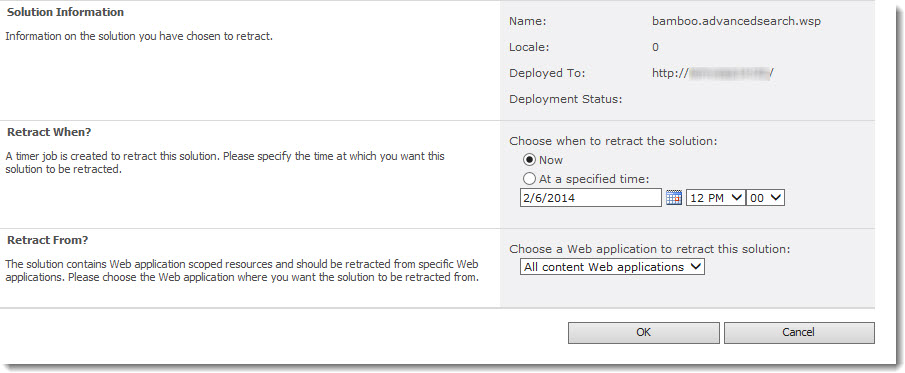


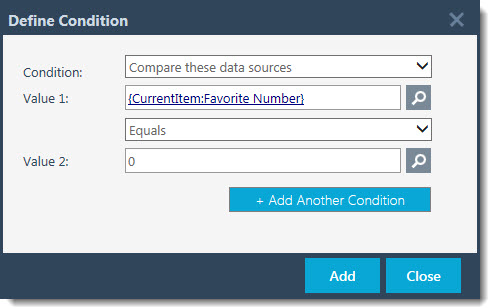
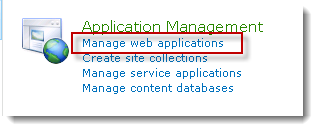
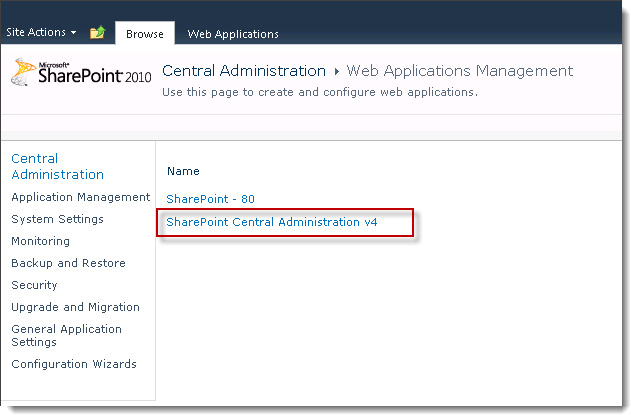

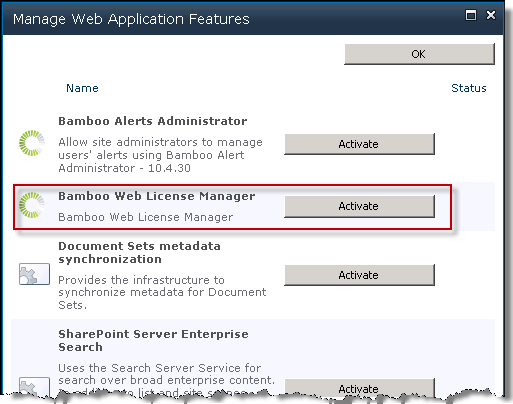
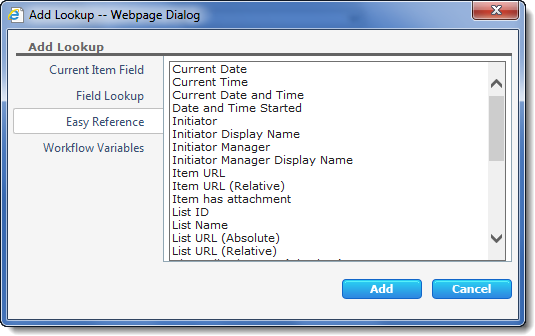 The Easy Reference lookup list contains common values related to the workflow and the SharePoint environment. Just like the other lookup types, Conductor retrieves Easy Reference lookups when the workflow reaches the widget. An example of an Easy Reference lookup is the workflow initiator, which would appear as {Reference:Initiator} in the widget property field.
The Easy Reference lookup list contains common values related to the workflow and the SharePoint environment. Just like the other lookup types, Conductor retrieves Easy Reference lookups when the workflow reaches the widget. An example of an Easy Reference lookup is the workflow initiator, which would appear as {Reference:Initiator} in the widget property field.

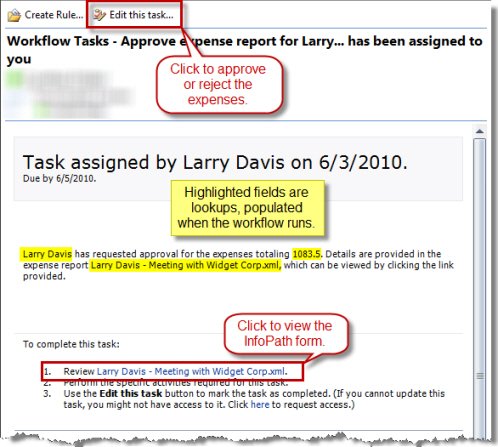
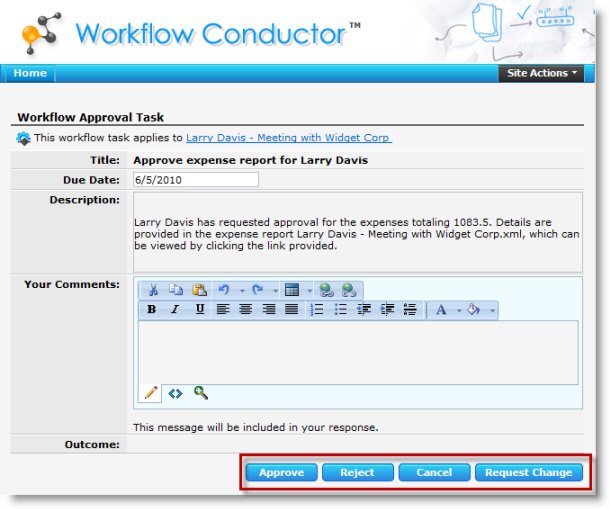

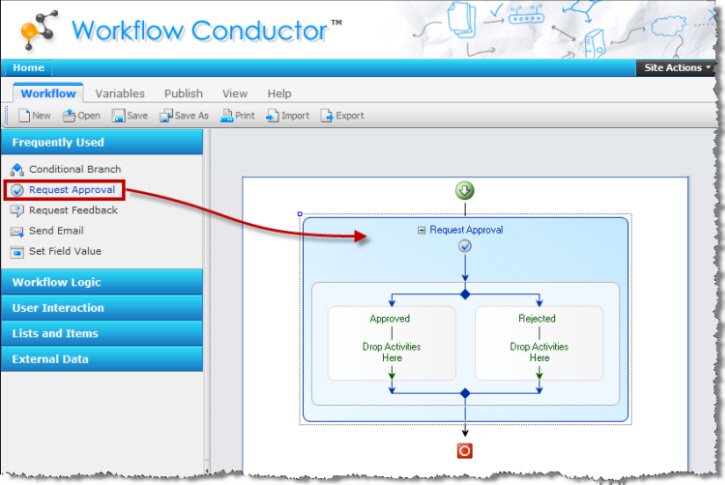




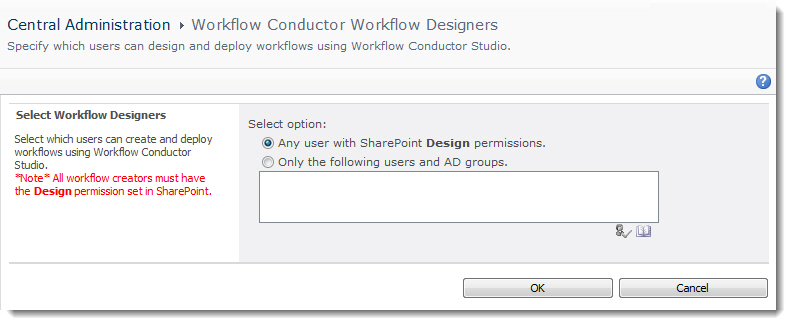 To specify who can design workflows in Conductor Studio, go to Central Administration > Workflow Conductor, and then click Workflow Designers. By default, any user with the SharePoint permission Design on the site and the list may also use Conductor Studio.
To specify who can design workflows in Conductor Studio, go to Central Administration > Workflow Conductor, and then click Workflow Designers. By default, any user with the SharePoint permission Design on the site and the list may also use Conductor Studio. By default, a saved workflow template can only be accessed by the designer who saved it, or by a
By default, a saved workflow template can only be accessed by the designer who saved it, or by a 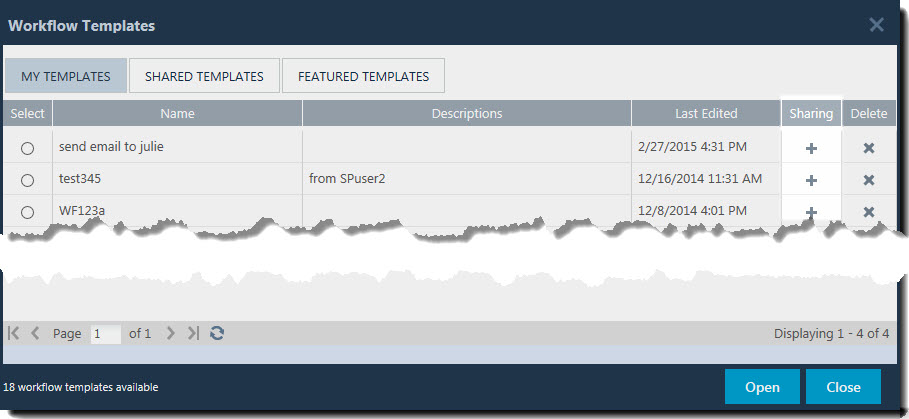 To share a template after it has been saved, open the template gallery and click the Sharing icon (
To share a template after it has been saved, open the template gallery and click the Sharing icon (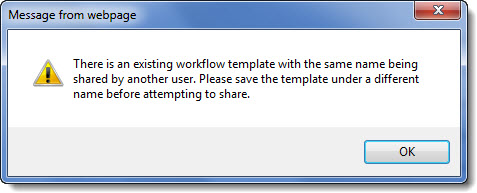
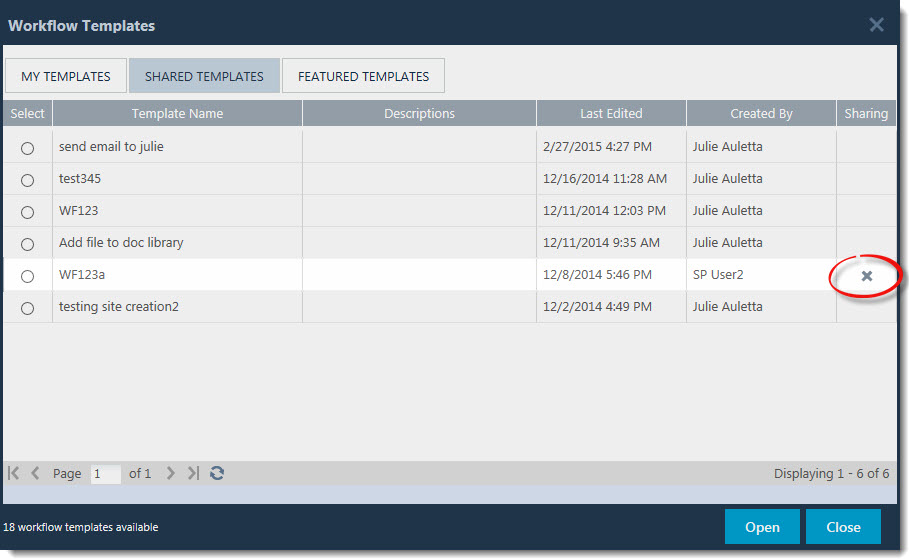 To remove a template from the Shared Templates list, click the Delete icon (
To remove a template from the Shared Templates list, click the Delete icon (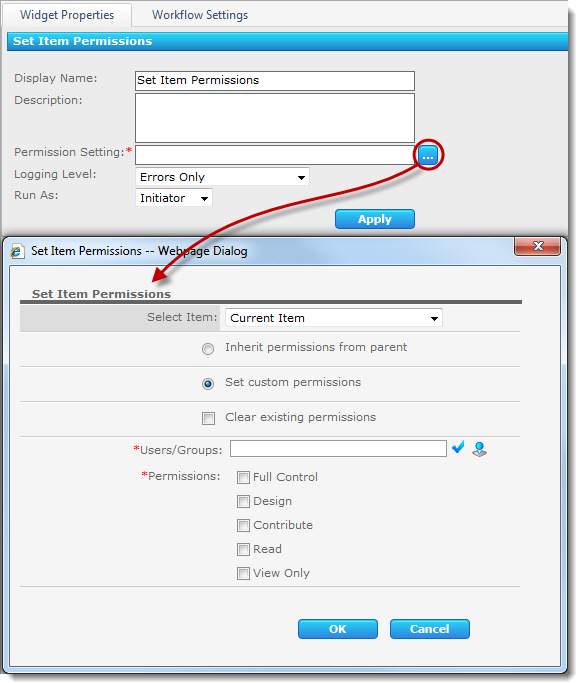
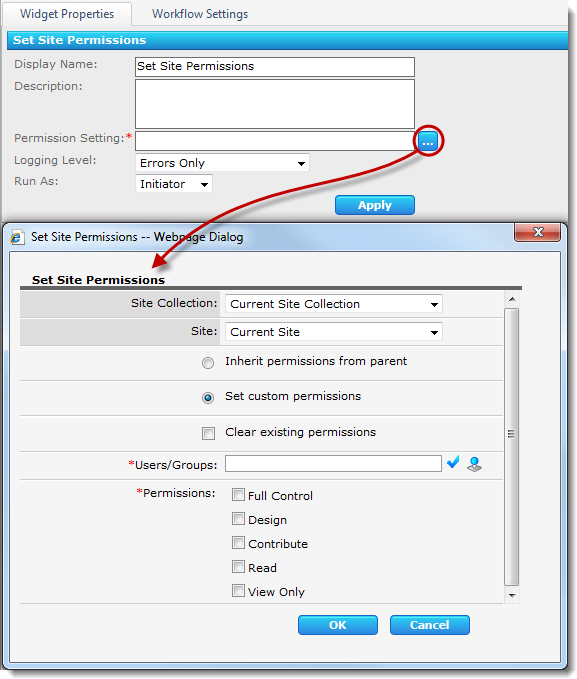
 Click the Save button in the Workflow Conductor ribbon.
Click the Save button in the Workflow Conductor ribbon. In the window that appears, enter a Workflow Name and an optional Description. If you’ve already given the workflow a name and description, they will be displayed.
In the window that appears, enter a Workflow Name and an optional Description. If you’ve already given the workflow a name and description, they will be displayed.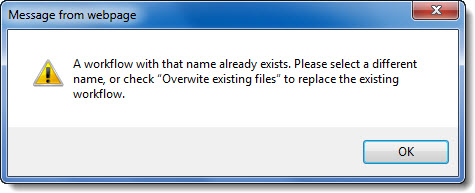
 If you forget to name your workflow template before attempting to save it, the Workflow Name box will be highlighted in red as shown. You cannot save a template without a name.
If you forget to name your workflow template before attempting to save it, the Workflow Name box will be highlighted in red as shown. You cannot save a template without a name. You may try to Publish your workflow before saving the template. If so, you will be prompted with the message shown. We strongly recommend that you save the template before publishing.
You may try to Publish your workflow before saving the template. If so, you will be prompted with the message shown. We strongly recommend that you save the template before publishing.
 If you click No to the prompt, deciding not to save the template before publishing, a warning message will be presented. You can choose to proceed to publish without saving, however it is not advisable.
If you click No to the prompt, deciding not to save the template before publishing, a warning message will be presented. You can choose to proceed to publish without saving, however it is not advisable.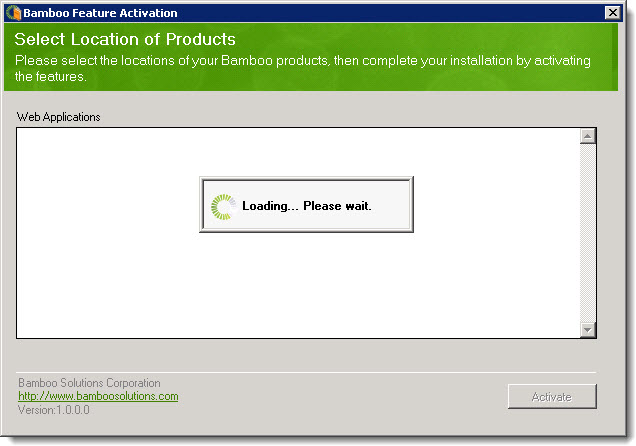 Highlight the Bamboo Feature Activation component in the Components section of the Workflow Conductor Setup program. When a component is selected, information specific to it is displayed on the right side of the interface.
Highlight the Bamboo Feature Activation component in the Components section of the Workflow Conductor Setup program. When a component is selected, information specific to it is displayed on the right side of the interface. The Web Applications available in your SharePoint farm will be loaded and displayed. By default, they will all be checked.
The Web Applications available in your SharePoint farm will be loaded and displayed. By default, they will all be checked. If Workflow Conductor is deployed to all web apps, click Activate. Otherwise, uncheck the appropriate web apps and then click Activate.
If Workflow Conductor is deployed to all web apps, click Activate. Otherwise, uncheck the appropriate web apps and then click Activate. When the processing completes, Activation Status information will be displayed.
When the processing completes, Activation Status information will be displayed.

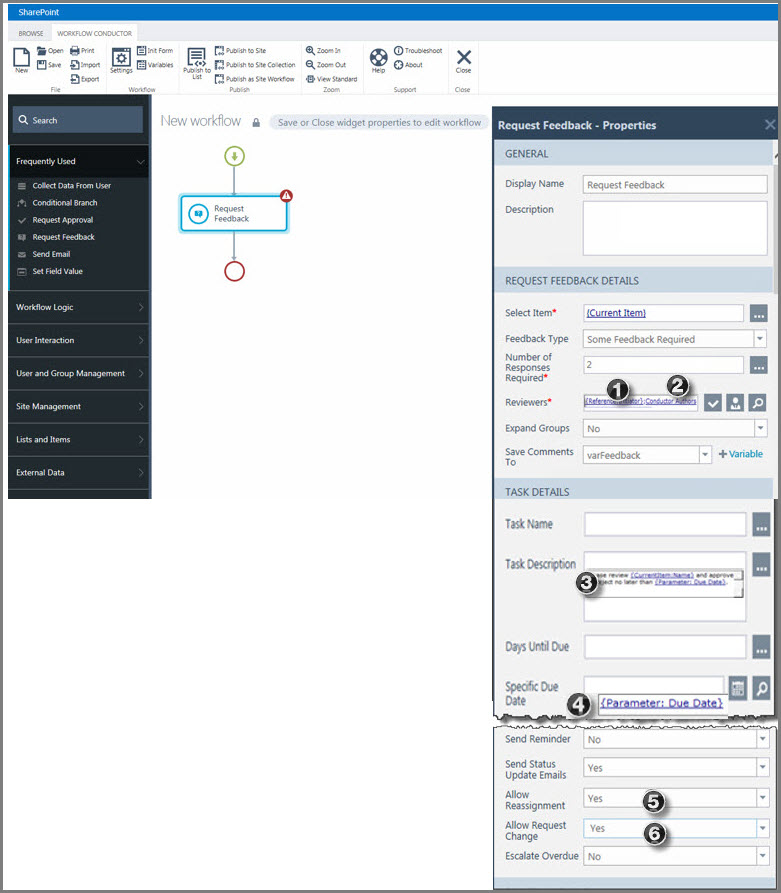 The screenshot here shows a configured Request Feedback widget with the following properties:
The screenshot here shows a configured Request Feedback widget with the following properties: When this workflow runs, the workflow initiator is prompted to enter a Due Date for the task using a workflow initialization form configured with the workflow. For details on configuring workflow initialization forms, see the Workflow Forms section.
When this workflow runs, the workflow initiator is prompted to enter a Due Date for the task using a workflow initialization form configured with the workflow. For details on configuring workflow initialization forms, see the Workflow Forms section.  After the workflow initiator enters a Due Date, the workflow starts by assigning tasks to the workflow initiator and the SharePoint group, as shown here.
After the workflow initiator enters a Due Date, the workflow starts by assigning tasks to the workflow initiator and the SharePoint group, as shown here.  In this example, e-mail notifications are sent to each person or group assigned a task.
In this example, e-mail notifications are sent to each person or group assigned a task.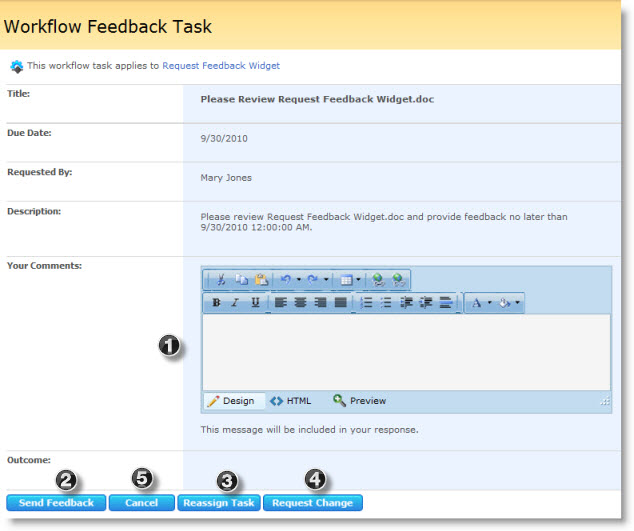
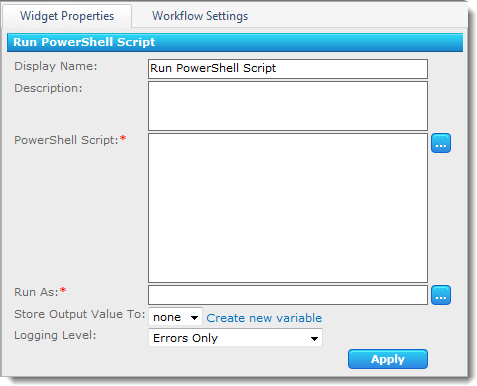 The Run PowerShell Script widget runs a Windows PowerShell script. The widget has the following features and options:
The Run PowerShell Script widget runs a Windows PowerShell script. The widget has the following features and options: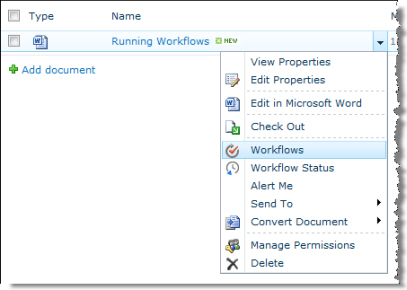



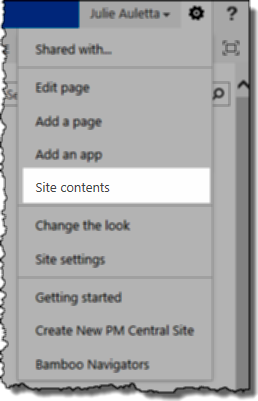



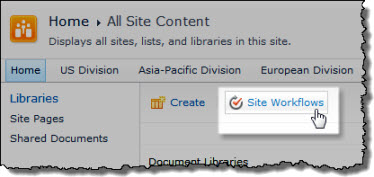
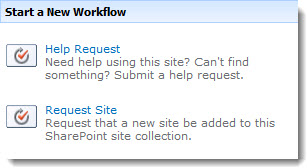


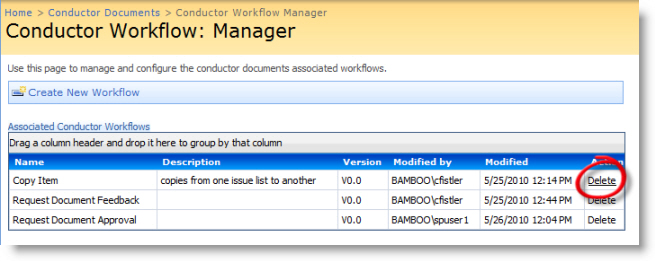


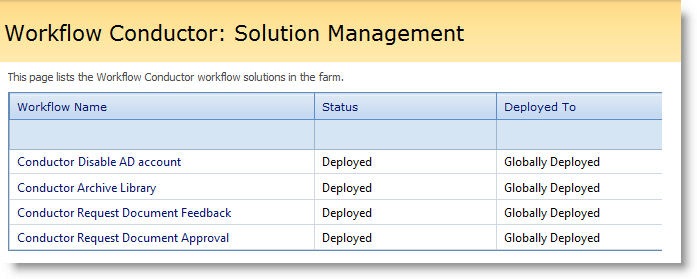
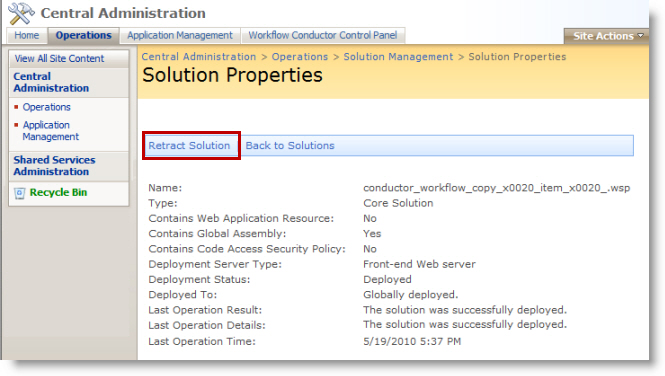
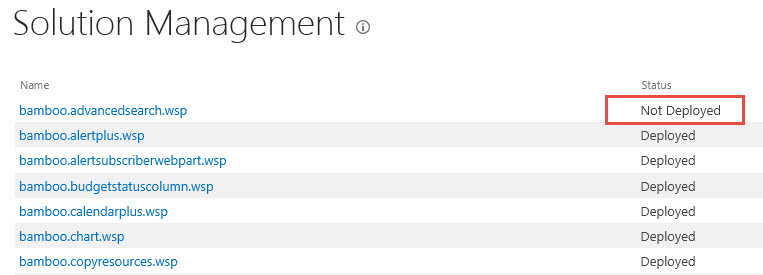

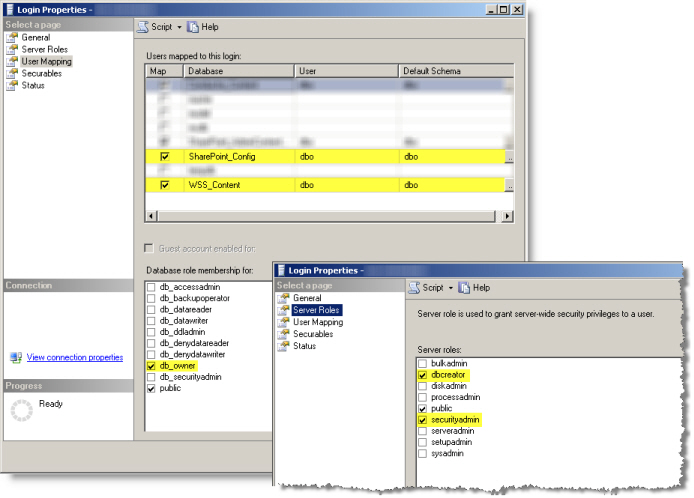
 If there is an error in your workflow, Workflow Conductor provides several ways to handle it. You can define error handling options per widget when the workflow is designed using the If Widget Errors property.
If there is an error in your workflow, Workflow Conductor provides several ways to handle it. You can define error handling options per widget when the workflow is designed using the If Widget Errors property. Request Change is an option reviewers and approvers have when completing Request Feedback and Request Approval tasks, and is not a separate widget. This option allows a reviewer or approver to create a new task for another user or group that must be completed before the original review or approval task. The Request Change option is available if the Allow Request Change property for the
Request Change is an option reviewers and approvers have when completing Request Feedback and Request Approval tasks, and is not a separate widget. This option allows a reviewer or approver to create a new task for another user or group that must be completed before the original review or approval task. The Request Change option is available if the Allow Request Change property for the 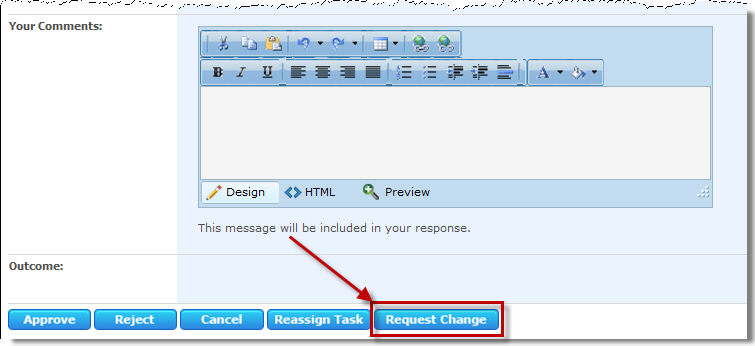
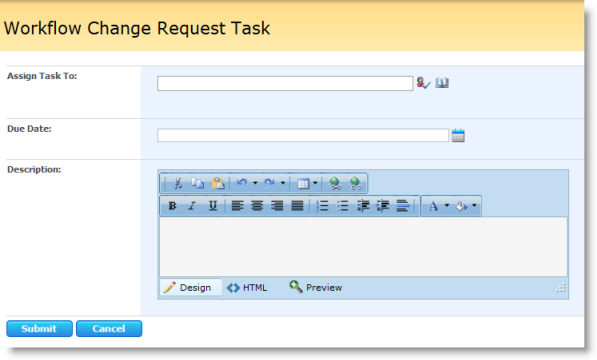


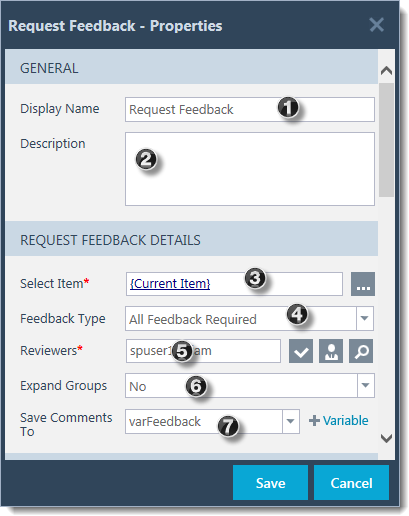 The Request Feedback widget assigns one or more users or groups a task to review an item in a list or library. Assigned feedback tasks are completed using a Workflow Conductor task form.
The Request Feedback widget assigns one or more users or groups a task to review an item in a list or library. Assigned feedback tasks are completed using a Workflow Conductor task form.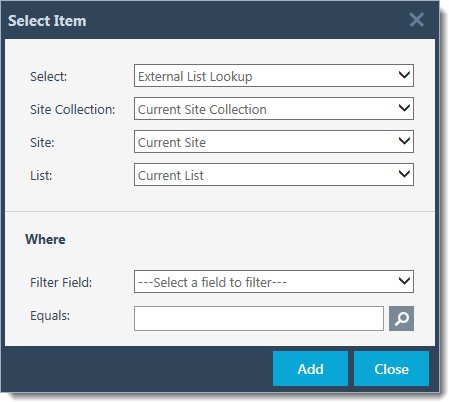 If you need to choose a different item, click the ellipsis icon (
If you need to choose a different item, click the ellipsis icon ( 
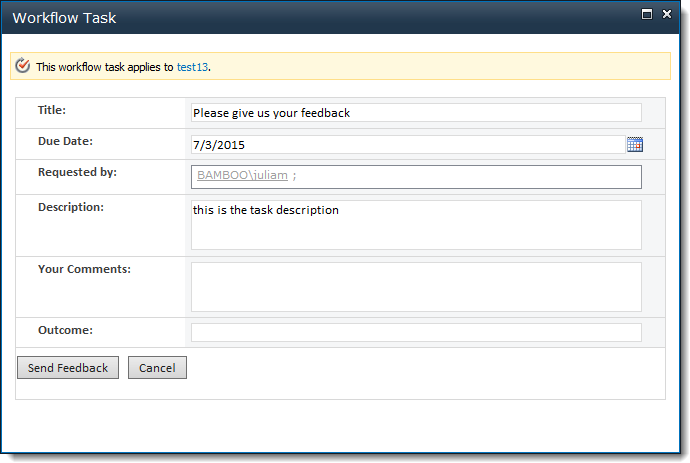 You can view task comments in the completed task.
You can view task comments in the completed task. Continuing to look at more of the widget’s properties, the screenshot here shows the Task Details of the widget properties:
Continuing to look at more of the widget’s properties, the screenshot here shows the Task Details of the widget properties: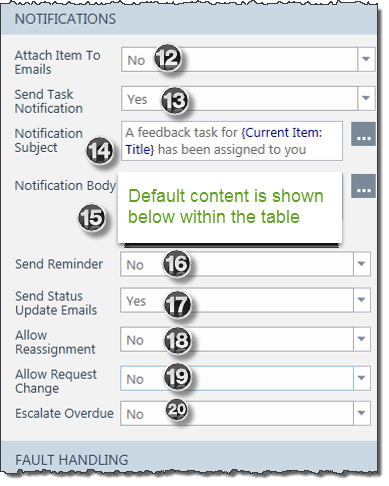 The next section of the widget properties covers the Notifications section:
The next section of the widget properties covers the Notifications section: It is possible to attach an electronic file to the email notifications (this option was added in WFC R3.5). When this option is set to Yes, the Item to Attach property appears.
It is possible to attach an electronic file to the email notifications (this option was added in WFC R3.5). When this option is set to Yes, the Item to Attach property appears.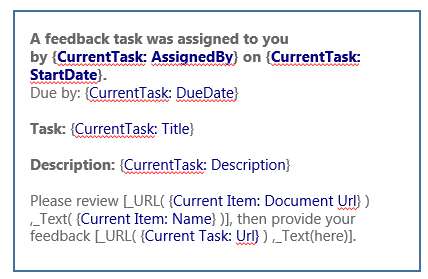 The default notification body contains a few tokens that may be of interest to you. Every item shown in blue is a lookup that looks up the actual data in the list.
The default notification body contains a few tokens that may be of interest to you. Every item shown in blue is a lookup that looks up the actual data in the list. When a task assignee clicks Reassign Task, a new task form appears (See below). The original task assignee enters a person to delegate the task to (Delegate To), a Due Date for the delegated task, a Description, and then clicks Submit. Another task is created for the workflow instance and the status of the original task is set to Completed.
When a task assignee clicks Reassign Task, a new task form appears (See below). The original task assignee enters a person to delegate the task to (Delegate To), a Due Date for the delegated task, a Description, and then clicks Submit. Another task is created for the workflow instance and the status of the original task is set to Completed. When a task assignee clicks the Request Change button on the task form, a form for a new task appears.
When a task assignee clicks the Request Change button on the task form, a form for a new task appears. 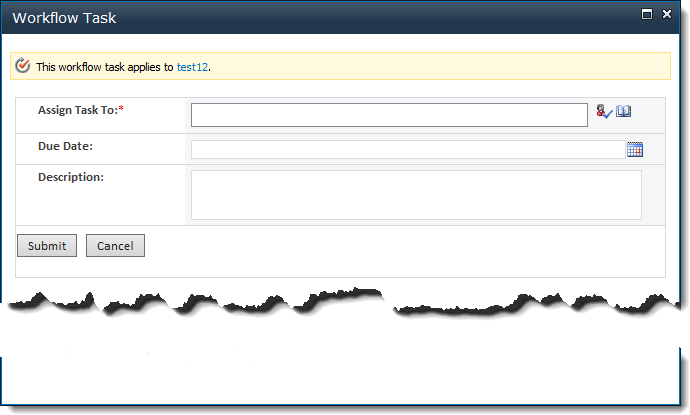
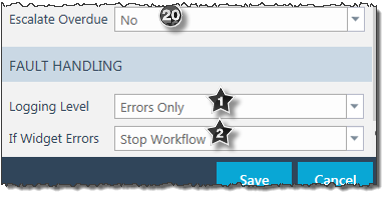 Workflow designers have the option to override the logging level configured for widgets and specify a new logging level for all widgets for that workflow instance as described below:
Workflow designers have the option to override the logging level configured for widgets and specify a new logging level for all widgets for that workflow instance as described below: ).
).
 In the Site Administration section, click Manage Site Reusable Workflows.
In the Site Administration section, click Manage Site Reusable Workflows.
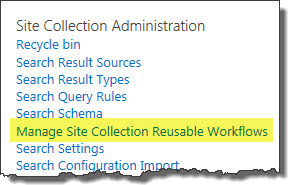 In the Site Collection Administration section, click Manage Site Collection Reusable Workflows.
In the Site Collection Administration section, click Manage Site Collection Reusable Workflows.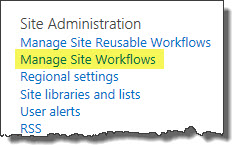 In the Site Administration section, click Manage Site Workflows.
In the Site Administration section, click Manage Site Workflows.

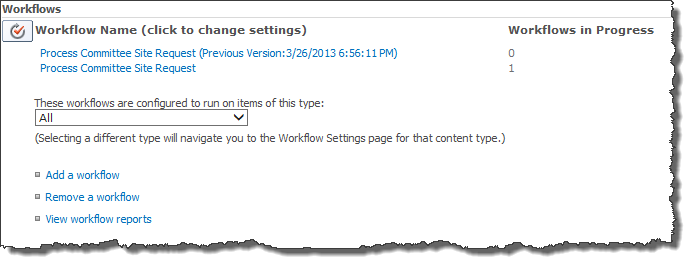

 ), click the Lookup User icon (
), click the Lookup User icon ( ) to search for a user in the User Lookup form, or enter a lookup to a user using the Add Lookup button (
) to search for a user in the User Lookup form, or enter a lookup to a user using the Add Lookup button ( ) in the User Lookup form.
) in the User Lookup form. 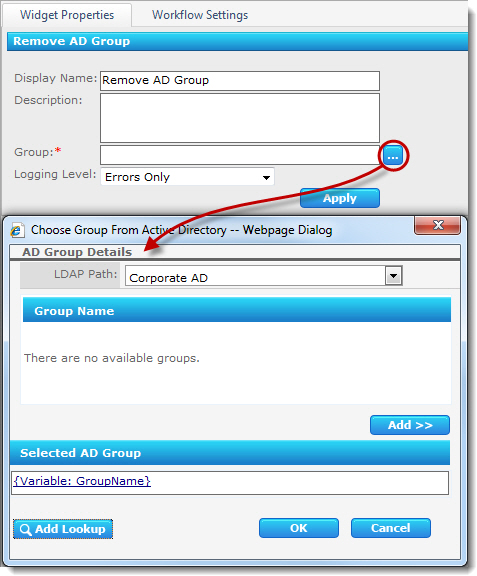 The Remove AD Group widget removes a group from a specified Active Directory location. The widget has the following features and options:
The Remove AD Group widget removes a group from a specified Active Directory location. The widget has the following features and options: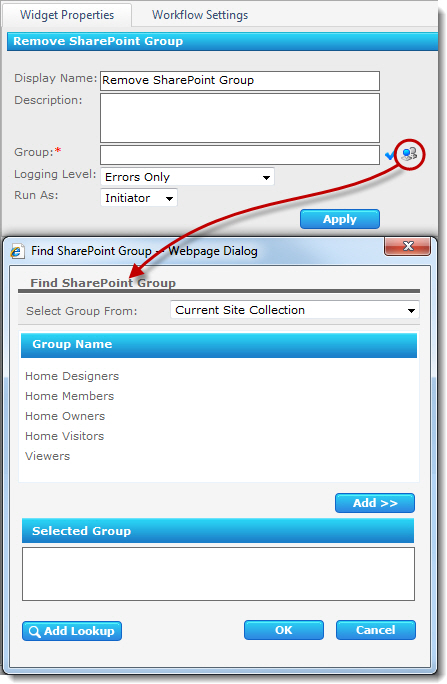 The widget has the following features and options:
The widget has the following features and options: